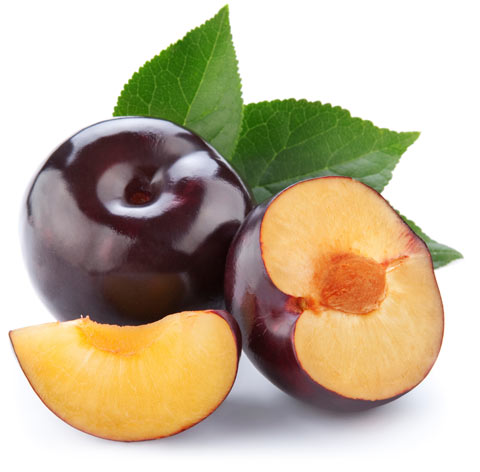Plums and Prunes

Plum fruits come from European (Prunus domestica) and Japanese plum (P. salicina) trees. European plums are a result of crossbreeding cherry plum and blackthorn trees in western Asia, and are believed to be the source of the varieties of plum trees used to produce prunes (brought to the U.S. in the 1850s). The Japanese plums are generally preferred for fruit eaten out of hand. (i.265)
Both are part of the Rosaceae family, and are a relative of many berries and other fruits (e.g., apples, blueberries, cherries, pears, raspberries, and strawberries). They can be used in both fresh and dry forms. Dried plums are known as prunes and are only made from plums that are sweet enough to be dried without fermenting. There are more than 2000 varieties of plums, with more than 100 types available in the US. However, they are grouped into six categories: American, Japanese, European/Garden, Ornamental, Damson, and Wild. They also come in a wide variety of colors, including purple, red, green, amber and blue-black. (i.42, 266-268)
Historically used as a food and in traditional herbal medicine for stomach and digestion problems and headaches, modern research suggests plums and prunes may also have cancer-fighting properties. Lab, animal, and human studies indicate that plums and prunes can help prevent tumor development, growth, and metastasis. (i.265)
Beneficial Nutrients in Prunes and Plums
Different research studies have shown that plums and prunes help to prevent cancer because of their antioxidant properties and polyphenolic components that inhibit carcinogenesis and mutagenesis. Plums and prunes contain phytonutrients that studies suggest may be responsible for the fruits' cancer-fighting properties. These include: (i.42, 99, 110, 137, 150, 269)
- Anthocyanidins. Plums and prunes are rich in cyanidin and pelargonidin. Anthocyanidins are the flavonoid polyphenols in plant pigments that make them red, purple, and blue.
- Hydroxycinnamic acids (caffeic, coumaric, protocatechuic, chlorogenic, and neochlorogenic acids). These non-flavonoid phenolic compounds have powerful antioxidant properties that can prevent oxygen-related damage to cells. Studies suggest antioxidant phenolic acids help detoxify, deactivate, and prevent activation of carcinogens. For example, protocatechuic acid helps to prevent the malignancy of epithelial cells. Phenolic acids also help prevent carcinogens from attaching to DNA and help improve DNA repair mechanisms.
- Flavanols (catechins and proanthocyanidins). Both plums and prunes are a rich source of these natural anti-inflammatory flavanol-type flavonoids. They block DNA methylation involved in many cancers, have immune-boosting effects, and inhibits proteins that get rid of DNA-damaged cells before they can replicate and grow into potentially malignant tumors.
- Resveratrol. A non-flavonoid stilbene-type compound in the skin of plums and prunes that animal studies show inhibits growth of breast, colon, esophageal, prostate, and skin cancer (when applied topically). Resveratrol also may help prevent metastases. Its cancer-fighting effects are enhanced when combined with curcumin (in turmeric spice) and vitamin E as well as some chemotherapy drugs.
Most polyphenols are potent antioxidants that studies demonstrate have bioactive beneficial effects, even though some clinical studies indicate that the antioxidants in prunes are not readily bioavailable in the blood 1-4 hours after consuming them (using H- and L-ORAC tests). For example, prune juice extracts have been shown to induce cancer cell death and suppress the growth of human colon carcinoma cells. (i.42, 117, 269)
Fiber Benefits
Plums and prunes are high in both soluble and insoluble fiber (18-30%); studies show foods containing 9-12% have antioxidant properties and also inhibit cancer cell proliferation. In both lab and animal research adding a small amount of prunes to a regular diet reduced the risk of colon cancer by decreasing the amount of fecal bile acids. Clinical studies showed that men who consumed 100 g/day of prunes also resulted in decreased bile acids, suggesting dried plums may lower the risk of colon cancer in humans as well. (i.121, 265, 270, 271)
Research has also demonstrated that the fruits help to lower the risk of breast cancer among postmenopausal women. Prospective population studies suggest that postmenopausal women who consume diets high fiber-rich fruit (such prunes or plums) may lower their of breast cancer by over 30% compared to women who don't. (i.271)
Antioxidant Vitamins and Minerals
In general prunes are higher in vitamins and minerals than plums. Both contain different antioxidant compounds. On the other hand, plums and prunes are low in fat and both contain vitamin C that helps the body to absorb iron better. Vitamin C also helps in boosting the immune system and preventing free radicals from oxidizing cholesterol and causing other damage that could lead to the development of colon cancer. (i.265, 267)
Plums have significant amounts of xanthophylls and beta-carotene, which are two different types of carotenoids. Prunes are a richer source of beta-carotene, with a quarter cup converting into 16.9% of the value of vitamin A the body requires every day. This fat-soluble antioxidant helps to neutralize free radicals that water-soluble antioxidants cannot reach. (i.121)
Of particular interest for its cancer-fighting properties is the trace mineral selenium. Prunes are a terrific source of selenium, and studies suggest that eating selenium-rich foods may lower the risk of cancer. Selenium metabolizes into three different compounds in the body that research indicates can protect cell DNA from damage. They also help regulate repair processes that keep cells with DNA damage from replicating and potentially developing into cancer. (i.53, 117, 269)
Buying and Preserving Plums
Plums are generally available between May and September in the United States. If you are interested in ripe plums that are ready to eat, go for the ones that respond to gentle pressure and whose tips are slightly soft. If you would like to ripen the plums at home, you will still need to avoid the ones that are too hard because they were most picked prematurely and won't ripen well. The color should be rich, preferably with some whitish bloom to avoid over-handled ones. Avoid bruised plums or those showing signs of decay. Leave the plums at room temperature and check them the following day because they mature relatively quickly. Fully ripe plums have the highest antioxidant content, with the content increasing up to the point where they start to decay. (i.266)
Buying prunes packed in transparent containers helps you to determine their quality. The prunes should appear to be shiny, plump, and mold-free. If you have to choose opaque packages, they must be tightly sealed to preserve moisture. Avoid the ones packaged with food preservatives. (i.266)
Preservation Methods
Canning: Although it is possible to scald and peel plums, the fruits are often canned unpeeled. If you want to prevent splitting while preserving whole, wash the plums and use a fork to prick the skin on two sides. The fruits may be canned in water, juice or sugar syrup, using one of these 2 methods: (i.271)
- Hot Pack: Heat the plums in boiling juice or syrup for two minutes. Cover the saucepan for about half an hour and then pack into jars. Cover with some boiling syrup, leaving about half-inch head space.
- Raw Pack: Place raw fruits into jars and cover with boiling syrup, leaving half-inch head space. Remove bubbles.
Freezing: Wash ripe and firm plums before halving and pitting them. Freeze either cooked with syrup or in sugar packs (1:5 sugar to fruit ratio). You may also freeze them whole without adding syrup or sugar. (i.271)
Drying: Select fully mature, sweet and fresh plums without any soft spots or blemishes. Wash the fruits and cut in half before pressing to flatten them. You may speed up the drying process by steam blanching the halves for one or two minutes. Dry at between 130-135°F. (i.271)
Plums may also be made into sauces, jams, or jellies. (i.271)



